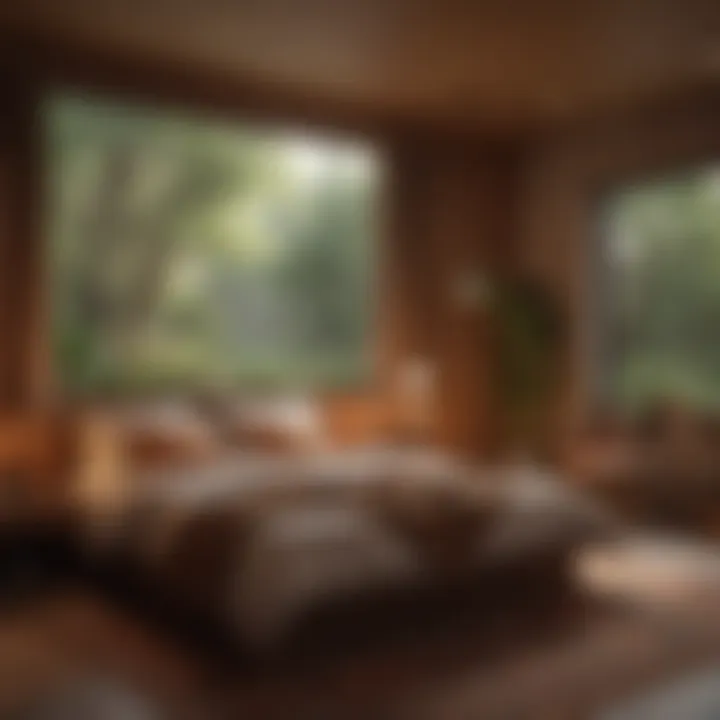Exploring How Bedroom Colors Influence Sleep Quality


Intro
Sleep is a precious commodity, often taken for granted until it's elusive. Many factors affect our slumber—stress, lifestyle, and perhaps surprisingly, the colors that envelop us in our personal sanctuary. As we dive into this subject, we discover how colors in our bedrooms can shape our experiences during the night.
This article will unpack the science behind color psychology, and discuss how various hues can impact your mood and relaxation levels. For instance, certain shades may evoke a sense of calm while others might stimulate thoughts, making it essential to choose wisely. This exploration is not just about aesthetic appeal; it’s about creating an environment conducive to restful sleep to enhance overall well-being.
Let’s take a deeper look at how color choices can lay the groundwork for a good night’s sleep, helping homeowners and interior design aficionados alike create havens of tranquility.
Design Inspiration
When it comes to creating a restful bedroom, inspiration often stems from current trends in interior design. The focus today leans towards holistic designs that encourage serenity, incorporating elements that connect us to nature and create inviting atmospheres.
Current Trends in Interior Design
Today’s designs often embrace soft, muted tones instead of bold or harsh shades. Popular colors include:
- Soft blues: These shades mimic the sky and ocean, promoting serenity and calmness.
- Gentle greens: Often associated with nature, greens can reduce anxiety and rejuvenate the spirit.
- Warm neutrals: Colors like taupe and off-white bring a cozy, inviting feel which is particularly appealing for a bedroom setting.
The modern trend also emphasizes natural materials that harmonize with these colors, such as wood or organic textiles. Integrating these elements can amplify comfort and enhance the relaxing qualities of the chosen hues.
Color Schemes and Palette Ideas
Choosing the right color scheme can feel overwhelming, but let’s simplify it by considering a few effective palettes:
- Ocean-themed: Soft blues, sandy beige, and crisp white can create a refreshing vibe that transports your mind to a coastal retreat.
- Earthy tones: Shades of brown, muted greens, and deep rust can evoke feelings of stability and warmth, grounding your space in comfort and calm.
- Pastels: Light blush, lavender, or baby blue can add a touch of whimsy without overwhelming the senses, gently guiding you toward relaxation.
Another approach is to use an accent wall with a bolder color while keeping the rest of the room in softer tones. This way, you can create interest without compromising the calming effect of the dominant colors.
"The right color can change the perception of space and profoundly influence our daily experiences—especially in the realm of sleep."
By tailoring your bedroom colors carefully, you pave the way for improved sleep quality and a more restful environment. When coloring your space, remember that the eyes and mind are closely linked. Colors that sooth the visual senses can similarly reduce mental clutter, promoting better sleep hygiene.
This assessment of bedroom colors reveals much about the relationship between hue and human emotions, proving that indeed, color matters significantly when it comes to our nightly repose.
Understanding the Psychology of Color
Color is more than just a visual element; it’s tied intricately to our emotions and mental states. When it comes to our bedrooms, the colors we choose can significantly influence how we feel and how well we sleep. After all, sleep is a lifelong partnership with our environment, and the hues around us play a key role in this relationship.
Understanding the psychology of color can prove beneficial in countless ways. First, it allows individuals to create personal spaces that nourish comfort rather than discomfort. Imagine walking into a room painted a calming shade of blue – it immediately eases tension and sets the stage for relaxation. Conversely, a fiery red might incite feelings of passion or energy, which is less ideal for winding down after a long day. Understanding how different colors affect us can lead to better choices when designing a restful sanctuary.
Considerations extend beyond mere aesthetics. Color perception often correlates with cultural background, personal experiences, and even biological factors. For instance, a soft pastel might inspire serenity, while a vibrant yellow has the potential to awaken creativity. This nuance is essential when selecting a palette that truly aligns with individual needs. Homeowners should reflect on what rejuvenates or calms them personally. A color that others find calming might strike someone else as too bland or overwhelming, reshaping the expectation of sleep quality in those instances.
Ultimately, gaining insight into color psychology arms individuals with the knowledge needed to foster environments conducive to relaxation, thereby enhancing overall sleep quality. To embark on the journey of curating a sleep-friendly space, it begins with recognizing how the mind interacts with color, and the effects those choices can yield in a sanctuary meant for restful slumber.
Color Perception and Emotion
The connection between color perception and emotion is profound. Colors elicit feelings— whether we acknowledge them or not. For example, researchers have found that blues and greens tend to elicit feelings of calmness and tranquility. These shades resonate with feelings of nature and still bodies of water. On the other hand, intense colors like red or orange can heighten feelings of anxiety or agitation, creating an environment that could disrupt a peaceful night’s sleep.
When setting a bedroom palette, it's important to consider how the space will make occupants feel. Beyond personal preference, take note of the various psychological responses different hues may evoke. Some individuals might prefer monochromatic designs, while others thrive in vibrant, colorful environments. Remember, the hues chosen are more than mere decoration; they are essential components that affect emotional health and well-being.
Theories of Color Psychology
Delving into theories of color psychology provides another layer of understanding. Various theories attempt to explain the connections between colors and emotional responses. One well-known concept is the Color Wheel, which classifies colors into categories like warm, cool, and neutral.
Warm colors, such as red, yellow, and orange, stimulate the brain and energize the body. This effect can be welcoming in social spaces but can also undermine restfulness in a bedroom setting. In contrast, cool colors—like blue and green—are often associated with tranquility and peace, promoting a soothing atmosphere conducive to sleep.
Also, it’s insightful to consider color harmony, a concept that emphasizes creating balance through distinct color relationships. A harmonious color scheme can establish a calming ambiance, making it easier to relax and drift into slumber. Integrating color theory into the bedroom design process not only enhances aesthetics but fundamentally contributes to enhancing sleep quality.
"The right color choices can elevate your tired body and mind into a better resting state—a true marriage of form and function."
Whether you aim for subtle touches or bold statements, exploring the depths of color psychology is an essential stepping stone towards creating a bedroom that truly supports the art of sleeping well.
Fundamentals of Sleep Science
Understanding sleep science is vital when discussing the influence of bedroom colors on sleep quality. It's not merely about aesthetic choices; it's about creating an environment that supports your body's natural rhythms and promotes restorative rest. By grasping the fundamentals of sleep, we can design spaces that nurture well-being and encourage healthy sleep patterns.
Circadian Rhythms and Sleep Patterns
Circadian rhythms act as our internal clock, regulating sleep-wake cycles over a 24-hour period. These rhythms respond to environmental cues, especially light and darkness. Essentially, when it’s light out, our bodies gear up for activity, and when darkness falls, our bodies signal for rest.
- Melatonin Production: A crucial player in this process is melatonin, a hormone that tells our body it's time to sleep. Melatonin levels naturally rise in the evening and drop with dawn.
- Sleep Cycle Stages: Our sleep is divided into stages, including REM (rapid eye movement) and non-REM. These cycles repeat throughout the night, impacting how rested we feel in the morning.
The bedroom's color can influence these rhythms. For example, soft blues mimic twilight, signaling to the brain it might be time to wind down. On the other hand, vibrant colors can disrupt these signals, causing restlessness or difficulty sleeping.
The Role of Environment in Sleep Quality
Your bedroom isn’t just a room; it’s a sanctuary for rest. Various elements—like noise, temperature, and, notably, color—can greatly affects sleep quality. This aspect cannot be overlooked, as an environment conducive to sleep is essential for effective rest.


- Color Temperature: Colors have various temperatures, which can either warm or cool a space. Warm colors like peach or beige can create comfort but might be overstimulating if they're too bright. In contrast, cooler shades promote calmness and relaxation.
- Acoustic Environment: Besides color, noise levels and their interactions with the color palette could either soothe or disturb. Soft colors paired with sound-absorbing materials may help reinforce a tranquil atmosphere, ideal for sleep.
- Visual Clutter: A visually cluttered room can lead to mental clutter. Selecting a coherent color scheme may not only enhance the room’s aesthetics but also create a sense of order that could help calm an overactive mind.
"A peaceful environment lays the groundwork for a good night’s sleep, and colors play an integral role in fostering that tranquility."
In summary, understanding the fundamentals of sleep science serves as the foundation for making informed decisions about bedroom design. By aligning interior choices with the body's natural processes, we can foster an atmosphere that enhances sleep quality.
The following sections will dive deeper into how specific colors can impact our emotional states and, in turn, our sleep.
Color Choices that Foster Relaxation
Choosing the right colors for your bedroom is more than just aesthetics; it lays the groundwork for tranquility and restfulness. Colors can stir emotions, evoke memories, and even influence physical states, making the selection of palettes vital in crafting a relaxing sanctuary. When done thoughtfully, the right colors can make a significant difference in your sleep quality. It’s not merely about what looks good; it also involves understanding personal preferences and the psychological effects that specific colors may elicit.
The impact of colors like soft blues, greens, and even gentle neutrals can create a calming effect conducive to sleep. Engaging with these tones not only shapes the atmosphere of your bedroom, but it also encourages a state of relaxation that can help you drift off more easily.
Each color speaks a language; here’s what the cool tones and neutrals can tell you.
Cool Colors: Blues and Greens
Psychological Effects of Blue
Blue is often lauded for its calming qualities. Studies suggest that this color is associated with tranquility and can significantly reduce anxiety levels. This reduction in stress is crucial when preparing for a good night’s sleep. Furthermore, it's a color that can symbolize stability, which in turn fosters a sense of security in one’s environment.
What makes blue a popular choice for bedrooms is its versatility. It can take on many shades—from the deep navy that envelops a room in richness to the light, airy sky blue that opens up space. In essence, blue's ability to cater to different tastes while maintaining a restful vibe is something that benefits any bedroom design.
Advantages of using blue:
- Creates a serene atmosphere.
- Can be paired effectively with a wide range of accessories and textures.
- Well-suited for both peaceful sleep and mindful relaxation.
Disadvantages of using blue:
- Overly dark or bright shades can be too stimulating if not balanced with lighter, more neutral tones.
The Soothing Nature of Green
Green is often connected to nature and renewal—it brings to mind lush forests and tranquil gardens. This connection with the natural world can evoke feelings of peace and relaxation. In bedrooms, green can serve as a breath of fresh air, renewing one’s spirit after a long day.
What sets green apart is its psychological grounding effect. It encourages balance and harmony, akin to finding your footing on solid ground after a turbulent journey. Importantly, studies have also shown that the color green can assist in lowering blood pressure and heart rates, which directly correlates to improved sleep quality.
Advantages of using green:
- Instills a sense of balance and calmness.
- Works well with both warmer and cooler accents, allowing for personalized decor.
- Adapts easily to various styles, from rustic to contemporary.
Disadvantages of using green:
- The wrong shade—perhaps one too bright—can evoke feelings of envy or agitation rather than calmness.
Neutrals: Grays and Whites
The Balance of Gray Tones
Gray is often seen as a sophisticated choice. It embodies elegance while serving as a palette that can seamlessly blend with other colors. Its neutrality provides a calming backdrop without overwhelming the senses. Choosing the right shades of gray can create a peaceful ambiance perfect for winding down at the end of the day.
Importantly, while gray neutralizes vibrant colors, it can also reflect light beautifully, enhancing the room's overall feel. Essentially, its adaptable nature allows for a peaceful yet stylish atmosphere.
Advantages of using gray:
- Offers a modern, clean look that feels uncluttered.
- Pairs well with various materials, from metals to wood, creating diverse decor options.
- Can help maintain serenity by preventing visual clutter.
Disadvantages of using gray:
- If used excessively or in darker shades, it might create a dreary environment rather than a cozy haven.
How White Creates Space
White is often perceived as a color of purity and peace. In bedrooms, employing white can create an open, airy feeling. It reflects light beautifully, making the space feel larger and more inviting. This openness can be particularly beneficial for promoting relaxation, as it helps reduce feelings of claustrophobia or confinement often associated with darker colors or cluttered spaces.
Importantly, white can be personalized through accents—bringing in textures and colors via linens or accessories to prevent a stark appearance.
Advantages of using white:
- Creates a serene, spacious feel.
- Easily matches any decor, making it versatile for change.
- Encourages a fresh, clean environment ideal for rest and rejuvenation.
Disadvantages of using white:
- Requires maintenance to keep its pristine appearance.
- It can feel sterile if not paired thoughtfully with other elements.
Color Choices to Avoid
When it comes to designing a restful bedroom, the colors you choose can either clear the path to tranquility or throw a wrench in the works. While many colors can lend a calming atmosphere, others can hinder sleep by triggering various psychological responses. It's crucial to avoid certain shades that rev up the senses instead of settling them.


Strong Colors: Reds and Yellows
Energy and Stimulating Effects of Red
Red is often described as a robust and powerful color. It grabs attention, making it a favorite for creating excitement and energy. Yet, it’s exactly this stimulating quality that makes red less than ideal for a sleep space. It can increase heart rate and heighten adrenaline, leading to restlessness, which is the opposite of what one needs for a good night's sleep.
- Key Characteristic: The boldness of red can evoke strong emotions.
- Benefits: Inspires action and boosts energy, adding vibrancy to communal spaces like living areas.
- Disadvantages: In the bedroom, it can interfere with relaxation, making it difficult to unwind and drift off.
Yellow's Impact on Mood
Yellow is often seen as a joyful, sunny hue. It evokes brightness and cheer; however, in a bedroom setting, this vibrant color can lead to mixed feelings. Its brightness can be overwhelming, potentially invoking feelings of anxiety or agitation rather than calmness.
- Key Characteristic: Bright shades of yellow are associated with optimism.
- Benefits: Perfect for social spaces or kitchens, as it tends to stimulate conversation and creativity.
- Disadvantages: In a bedroom, it can lead to restlessness and disrupt the ambiance meant for sleep.
Darker Shades: How They Affect Mood
Black and Dark Gray
Black and dark gray are colors often associated with sophistication and elegance. They can add a moody or dramatic flair to a bedroom. However, these colors can also absorb light and create a sense of confinement. This can feel stifling, especially in smaller spaces, making the atmosphere less inviting for rest.
- Key Characteristic: Provides a grounding effect but can also feel heavy.
- Benefits: Stylish in design, giving a modern edge to decor.
- Disadvantages: Risks overwhelming the space, creating a sense of gloom and inhibiting relaxation.
The Psychological Weight of Dark Colors
Darker colors carry a depth that can feel comforting, cozily wrapping you up in their embrace. However, they also come with a psychological weight that some might find too heavy for a bedroom environment. They can invoke feelings of sadness or introspection, making it hard to maintain an uplifting atmosphere conducive to restful sleep.
- Key Characteristic: Dark colors can invite introspectiveness.
- Benefits: Beautiful in moderation, often used for accent walls to create a chic contrast.
- Disadvantages: Can easily overwhelm if overused, creating a dungeon-like effect.
Avoiding the wrong colors can make all the difference in creating a bedroom that promotes tranquility and restful sleep. Choosing wisely can help you create an environment where peace reigns, making every night a good night.
Personalizing Your Space
Creating a bedroom that aligns with personal preferences is crucial to enhancing sleep quality. This space is where one unwinds, reflects, and resides through the night. A personalized bedroom can cater to individual moods and reduce stress, ultimately crafting a more favorable environment for rest. Considering the color palette is a significant element of this personalization. When a bedroom resonates with the occupant’s tastes, it becomes a sanctuary, encouraging relaxation and better sleep.
Identifying Your Preferences
Conducting Self-Assessment
Engaging in a self-assessment is the first step in identifying color preferences. This involves reflecting on how certain colors make you feel and how they might influence your mood. For instance, if serene blues evoke calmness, it may be a good fit for the bedroom. The beauty of self-assessment lies in its simplicity; it enables you to tune into your emotional responses to colors, thereby making informed choices. This practice can illuminate preferences that you might not have consciously acknowledged.
The key characteristic of conducting self-assessment is its focus on individual feelings. It invites you to think deeply, exploring various colors and their implications for personal well-being. One notable advantage is that it offers insight into your preferences without needing extensive design knowledge. This is particularly beneficial because each person’s emotional landscape varies, and tailoring the bedroom accordingly can create a more inviting and restful haven.
Exploring Color Preferences
Once self-assessment is completed, it's time to explore specific color preferences that resonate most effectively with you. This exploration not only considers personal tastes but also how different colors impact mood and sleep patterns. For example, soft pastels might be a wise choice for those seeking tranquility, while richer tones may align better with individuals desiring warmth and coziness.
A pivotal characteristic of exploring color preferences is its integration of psychology and emotion. This process is popular within the realm of home decor, as it translates the science of color into actionable design choices. The unique feature of this approach lies in its adaptability; it allows you to blend personal aesthetics with functional needs. However, one must be cautious of trends that may not align with individual sensibilities, as following them blindly could lead to dissatisfaction in the long run.
Combining Colors for a Balanced Scheme
The right combination of colors can make or break the overall ambiance of a bedroom. It is essential to strike a balance that promotes relaxation while still reflecting your personality. Combining colors thoughtfully can create a harmonious environment conducive to sleep.
Using Accent Colors Wisely
In any design scheme, accent colors play a vital role in adding depth and excitement. When applied wisely, they enhance the primary color palette without overwhelming it. For example, a soft green may be the base, while deeper green accents can add contrast and dimension. This method draws attention to specific areas or features in the room, creating focal points that uplift the overall design.
The essence of using accent colors wisely is to complement rather than contrast the primary hues. This balance can be both beneficial and popular among design enthusiasts. One unique feature of using accents is their potential to transform even the simplest room into an interesting space without altering the core colors. Nevertheless, excessive use of accent colors can disrupt harmony, and finding that sweet spot requires careful consideration.
Creating Harmony with Color
Creating harmony with color involves blending hues that not only satisfy aesthetic desires but also enhance functionality and comfort. This harmony is crucial, as it has a direct impact on sleep quality. By ensuring that the colors coexist pleasingly, you foster an atmosphere ripe for relaxation. A unified color scheme can help in mitigating visual clutter, allowing for a more tranquil space.
A key characteristic of creating harmony is its focus on cohesion. This is particularly beneficial as it promotes a soothing environment, reducing visual distractions that might interfere with sleep. The unique advantage of a harmonious space reflects on an individual’s subconscious mind, paving the way for improved rest. However, one must exercise caution—overly matching colors could lead to monotony, so subtle contrasts should also be embraced to maintain visual interest.
In summary, personalizing your bedroom is paramount for sleep quality, promoting a restful haven that reflects personality and preferences.
Tips for Implementing Color Changes
This section provides practical methods and approaches to implement color changes—even if you are not an expert in interior design. With the right techniques, anyone can breathe new life into their bedroom while also improving their sleep quality.
Painting Techniques for Bedroom Surfaces
Choosing the Right Finishes
Finding the perfect finish for your walls is a key component in successfully deploying a color palette. The choice of finish can significantly shift the ambiance of the room. For example, a matte finish absorbs more light, giving off a cozy and intimate feel, which can be particularly useful in creating a restful environment. In contrast, a satin or gloss finish reflects light, which could energize the space but might not be ideal for winding down.
Using a flat or eggshell finish is also a common and beneficial choice in this article. It can mask imperfections better than glossier finishes and promote a tranquil backdrop, aiding in establishing the mood for sleep.


Sample Testing for Visual Impact
It’s easy to get hung up on color swatches—what looks appealing on paper may be a different story once it’s on the wall. That’s where sample testing comes into play. By actually painting small sections of your walls with the colors you’re considering, you can gauge how they feel in your space over a few days or nights. Different times of day will cast varied light on the color, thus affecting its overall perception.
This method is especially helpful since colors can seem quite different in varying lighting conditions. Keep in mind; what looks calming in daylight might appear harsh under artificial light, so sample testing allows for a holistic, real-world evaluation.
Coordinating Bedroom Decor
Textiles and Accessories
Textiles and accessories play a major role in the feel of your bedroom. Curtains, bedding, and other textiles should complement your chosen color scheme while maintaining a harmonious flow. For instance, flowing fabrics in soft creams and whites can ease the eyes when set against a backdrop of delicate blues. This kind of balance creates a cozy retreat and helps the mind relax—readying you for sleep.
Additionally, these elements can introduce various textures, which enhance the sensory experience of the room, further impacting sleep quality. However, too many competing colors or busy patterns can lead to distraction, so it’s worth keeping your decor coordinated and uncluttered.
The Role of Lighting in Color Perception
Lighting is often an unsung hero in setting the mood of any room, including the bedroom. In harmonious color schemes, the type of lighting used becomes critical in depicting the colors accurately and creating the desired sleep environment. Warm, soft lighting enhances lighter colors while softer whites may intensify cool tones, altering the perceived mood of the room.
By using lamps with adjustable settings, you can experiment and adjust as needed to see what fits best. Ultimately, the right lighting can enhance or negate the effects of your chosen colors, acting as a useful tool in achieving the optimal sleep space.
"Creating a sanctuary for sleep involves more than just color; it's about the collection of elements that establish an atmosphere conducive to rest and relaxation."
Evaluating the Impact of Color Choices
Understanding the impact of color choices in the bedroom is vital to creating a restful and restorative environment tailored to your individual needs. It goes beyond merely slapping a new coat of paint on the walls; it’s about how these colors interact with your psyche and your biology. Colors can evoke feelings, ignite moods, and even affect the very quality of sleep you experience. For homeowners and design enthusiasts alike, evaluating color choices thoughtfully opens doors to incorporating psychology and sensory experiences into ultimate comfort and relaxation.
Monitoring Sleep Quality After Redecorating
Methods for Tracking Sleep Patterns
Keeping tabs on your sleep patterns after redecorating takes some diligence, but it’s absolutely worthwhile. People often underestimate how different shades can influence their nightly rest. To truly get a grip on the effects of your color adjustments, consider using sleep trackers or a simple journal to record your sleep hours and feelings upon waking.
- Key Feature: Data Accuracy - Utilization of modern sleep apps allows for precise tracking, revealing trends that might be missed otherwise.
- Benefits: Many of these apps provide insights on duration and quality of sleep, offering a comprehensive picture of how your adjustments are affecting you.
- Consideration: Keep in mind that external factors—like stress levels or lifestyle changes—could skew results, necessitating a longer observation period for clarity.
Adjusting to Color Changes
Transitioning to new hues can be a bit jolting, especially if the colors are significantly different from what you've had before. Allowing yourself time to adjust to these fresh shades is essential for reaping their full benefits. Instead of changing everything at once, gradual implementation can make a world of difference, letting you gauge how your sleep evolves along with your decor.
- Key Feature: Incremental Change - By adding changes gradually and noting your sleep quality, you can better assess the impact of each color.
- Benefits: This method can help reduce the shock of new colors, allowing your mind and body to acclimate.
- Consideration: However, be prepared for potential disparities in mood during the adjustment period as your mind reacts to the new environment.
Seeking Professional Advice
Consulting with Designers
Bringing in the expertise of a designer can make the journey of color selection much smoother. Designers have an intuition about color relationships and their psychological effects. They can help you choose shades that not only fit your aesthetic but also promote the kind of sleep quality you're after.
- Key Feature: Expertise in Color Psychology - Designers are often well-versed in color psychology and the impacts hues can have on emotions and behaviors.
- Benefits: This authority saves you time and energy, potentially leading to choices that optimize your sleep experience right off the bat.
- Consideration: Though they might charge for their services, the insights gained could far surpass any initial investments in trying to figure it all out alone.
Understanding Therapeutic Color Use
Therapeutic color use delves into how specific colors can aid mental and emotional health, which is intrinsically linked to how well you sleep. Colors like soft blues and greens are often celebrated for their calming effects, while warmer tones can feel more stimulating. Fostering awareness of these associations aids in crafting a soothing environment conducive to sleep.
- Key Feature: Holistic Approach - This perspective integrates health and wellness into design, emphasizing that the right color can do more than beautify; it can heal.
- Benefits: Incorporating these insights can lead to a more harmonious bedroom, potentially improving not only sleep quality but overall well-being.
- Consideration: One must approach color changes with an understanding of personal reactions, as individual responses can vary widely—what soothes one might irritate another.
"Colors, as they influence our emotions, can make a significant difference in our sleep quality. It's not a mere decoration but a pathway to better health."
Evaluating color choices in your bedroom marries emotion with science, opening doors not only to visual satisfaction but, more importantly, to improved sleep. This combination can be powerful for any individual looking to enhance their sleeping sanctuary.
Culmination: Finding Your Ideal Sleep Environment
When it comes to crafting the perfect sleep environment, the significance of color cannot be overstated. The hues that surround us in our bedrooms can influence our emotional states and, by extension, our overall sleep quality. Understanding this delicate balance is vital for anyone seeking to enhance their restfulness at night. It's not just about making a space visually appealing; it involves considering how colors affect your mood, relaxation, and ultimately, your ability to drift into a peaceful slumber.
In this exploration, we have uncovered the depth of color effects on sleep. The calming blues and greens emerge as favorites, fostering a serene atmosphere ideal for unwinding after a taxing day. Conversely, vibrant reds and yellows can spur activity and excitement, making them less than ideal for a restful night. The choice of colors also extends to the use of neutrals, providing a grounding effect that can balance and calm the mind.
"Color is the keyboard, the eyes are the harmonies, the soul is the piano with many strings." - Wassily Kandinsky.
This quote resonates as it reflects the symbiotic relationship between our environment and our state of mind. The colors we select for our bedrooms work together harmoniously, akin to a well-composed piece of music, each shade contributing uniquely to the overall ambiance.
A well-thought-out color palette is not a mere aesthetic choice; it is a crucial part of improving sleep hygiene. Therefore, as individuals evaluate their living spaces, they should think critically about how their color selections might impact their nightly rest.
Recap of Color Effects on Sleep
Throughout this article, the connection between bedroom color and sleep quality has been made evident. The psychological impacts of various colors play a prominent role.
- Cool colors, such as blue and green, provide a tranquil setting that encourages relaxation and promotes deeper sleep.
- Neutral tones like grays and soft whites are versatile, allowing for a sense of spaciousness without overwhelming the senses.
- Warm colors, especially vigorous reds and yellows, tend to energize and stimulate, potentially leading to disrupted sleep.
- Darker shades like black and dark gray, while potentially dramatic, can weigh on mood and create feelings of confinement or sadness.
Ultimately, the blend of these colors can either elevate or detract from your sleep experience. This understanding empowers homeowners and design enthusiasts to make informed choices that align with their preferences and needs.
Encouragement for Exploration
As you reflect on your bedroom’s color scheme, it is essential to approach this process with an open mind. Your sleeping space should be a canvas for experimentation. Try to be mindful about the emotions that different colors evoke in you. Begin with small adjustments, perhaps a fresh coat of paint or new bedding that introduces your desired hue.
Don't hesitate to test different shades and observe their effects on your mood and sleep patterns. This could be done by:
- Creating a mood board featuring your preferred colors.
- Sampling paint on the walls before committing to a single color.
- Incorporating colored textiles like curtains or throws to see how they change the room's atmosphere.
Color choice is about personal expression as much as functionality. Exploring different settings not only enriches your living space but also enhances your understanding of how your environment impacts your rest. Encouraging such a journey will lead to a more profound experience of ownership over one’s surroundings and ultimately to improved sleep quality.



